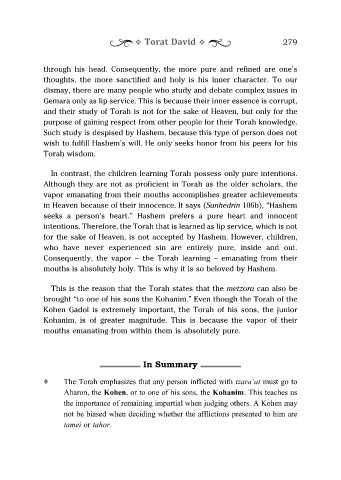Page 293 - VAIKRA
P. 293
The word “Pesach” is a derivative of the words (mouth) and (that
speaks). This signifies that the mouth of a person should speak about the
miracles of the Exodus from Egypt and discuss words of Torah. In this
way, a person will avoid speaking disparagingly. This is why parashat
Metzora is read close to Pesach. It underscores that a mouth that is not
engaged in speaking about the miracles of the Exodus and discussing
Torah ultimately begins speaking lashon hara. Consequently, a person is
punished with tzara’at. This is the reason why the Torah specifically
wrote “ – This shall be the torah of the metzora.”
It teaches a person that if he occupies himself in discussing words of
Torah, he will not come to speak words of lashon hara.
The slanderer is brought to the Kohen against his will in order that he
should not have the opportunity to begin slandering the Kohen. If he
would wait to come on his own, his mouth would begin spouting lashon
hara against the Kohen in the interim. This is a severe transgression.
Bringing the person to the Kohen also serves to humble him, eliminating
the trait of haughtiness, which is the cause of lashon hara.
The word (and he is brought), has the same gematria as the Name
(adding one for the word itself). This name is the source of all
the holy Names, which stem from it. Hashem revealed His Name
to Am Yisrael prior to the redemption. This is because He knew that this
Name would be familiar to Bnei Yisrael. However, if this Name was
known to them, why did Moshe suspect that Bnei Yisrael would ask for
Hashem’s Name? Conversely, if Am Yisrael did not recognize this Name,
then what purpose would be served in revealing it to them?
Moshe wanted to know which Name to use when introducing his mission
to Am Yisrael, in order to stimulate them in fulfilling their purpose of
ultimately accepting the Torah. Prior to Creation, Hashem had only one
Name, . At that time, the neshamot of Am Yisrael and the Torah The Torah emphasizes that any person inflicted with tzara’at must go to
already existed. Therefore, the neshamot of Am Yisrael already Aharon, the Kohen, or to one of his sons, the Kohanim. This teaches us
recognized the Name and the Torah. Moshe requested permission the importance of remaining impartial when judging others. A Kohen may
to reveal the Name to Am Yisrael, which would remind the not be biased when deciding whether the afflictions presented to him are
neshamot of Yisrael of their existence prior to Creation, when they # tamei or tahor. 26347-EYAL-6BOOKS - 26347-Vaikra-EYAL | 10 - A | 18-08-19 | 15:24:55 | SR:-- | Black 26347-EYAL-6BOOKS - 26347-Vaikra-EYAL | 10 - A | 18-08-19 | 15:24:55 | SR:-- | Magenta 26347-EYAL-6BOOKS - 26347-Vaikra-EYAL | 10 - A | 18-08-19 | 15:24:55 | SR:-- | Cyan #26347-EYAL-6BOOKS - 26347-V
10
vaikra

